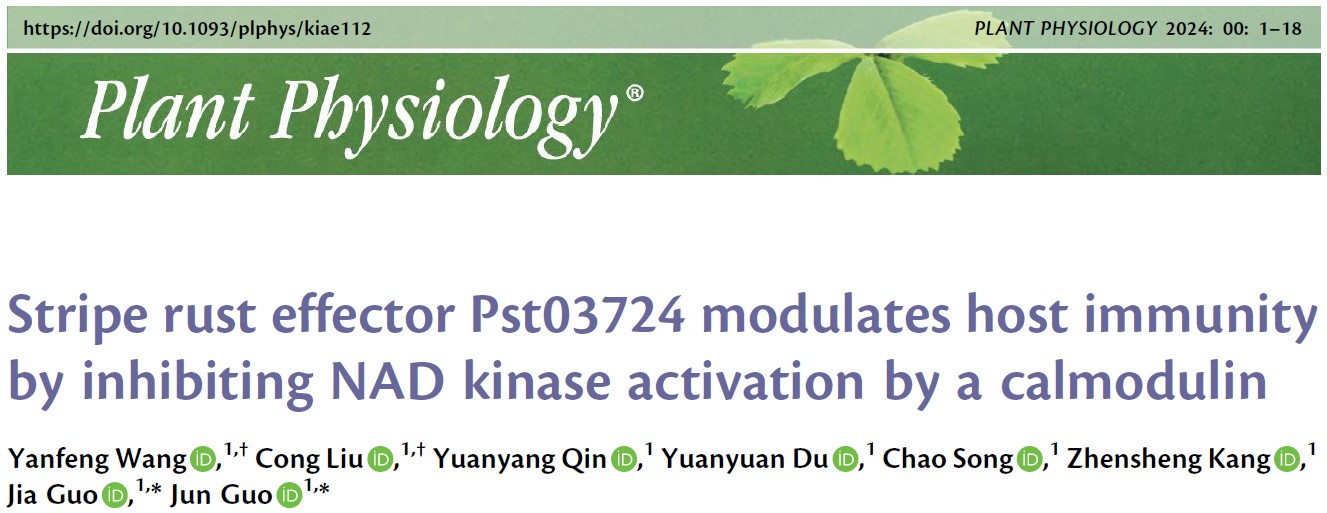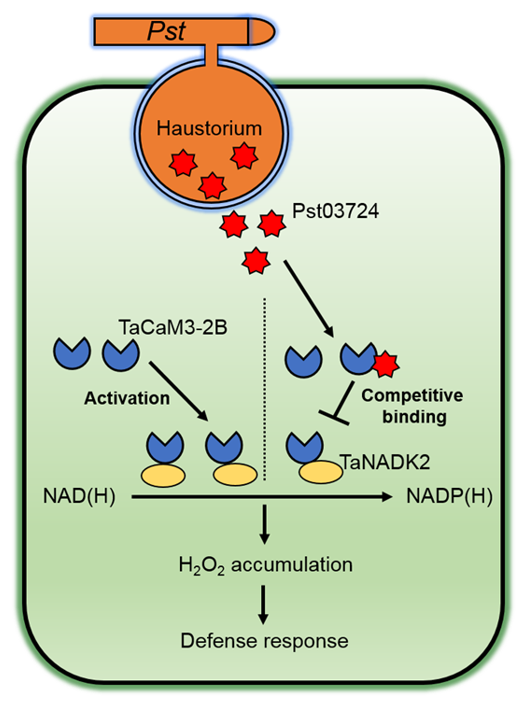Recently, the research group led by Prof. Guo Jun from our college published a research paper titled "Stripe rust effector Pst03724 modulates host immunity by inhibiting NAD kinase activation by a calmodulin" in the internationally renowned academic journal Plant Physiology. This study identified a stripe rust-specific effector Pst03724, which competes with TaNADK2 to bind TaCaM3-2B to interfere with the activation of TaNADK2 by TaCaM3-2B, thereby inhibiting the accumulation of H2O2 and promoting the infection of stripe rust. Ph.D students Wang Yanfeng and Liu Cong from our college are the co-first authors of this paper, and Prof. Guo Jun and Associate Prof. Guo Jia are the corresponding authors.

Calcium (Ca2+) signaling and nicotinamide adenine dinucleotide (NAD) signaling are two basic signal regulation pathways in organisms, playing important roles in plant energy metabolism, growth and development, and responses to biological and abiotic stresses. Calmodulin (CaM) and nicotinamide adenine dinucleotide kinase (NADK) are important interactive hubs of these two signaling pathways. CaM is a Ca2+ sensor widely found in eukaryotic cells that activates downstream signaling pathways by decoding Ca2+ signals. NADK is the only enzyme that can catalyze the synthesis of NADP (H) from the substrate NAD (H) and ATP, playing an important role in maintaining intracellular redox balance and responding to stress. CaM is a key regulatory factor for NADK activation. However, there have been no reports on how pathogen effectors regulate plant CaM and NADK to interfere with plant immunity.
In this study, transgenic wheat materials overexpressing TaCaM3-2B were created, and it was found that the accumulation of H2O2 induced by pathogen infection was significantly increased in TaCaM3-2B overexpressing lines, and the resistance of wheat to stripe rust was significantly enhanced. It was confirmed that TaCaM3-2B can interact with wheat NAD kinase TaNADK2 and activate its enzyme activity. After transient silencing of TaNADK2, it was found that the resistance of wheat to stripe rust was weakened, suggesting that TaCaM3-2B-TaNADK2 positively regulates the resistance of wheat to stripe rust. Further screening and identification revealed that the stripe rust-specific effector Pst03724 can interact with TaCaM3-2B, and it was found that it can compete with TaNADK2 to bind TaCaM3-2B, thereby inhibiting the enzyme activity of TaNADK2 and interfering with plant immune responses. This study deepens our understanding of the functions of calcium signaling and NAD signaling pathways in plant-pathogen interactions, enriches the diversity of effectors regulating host immunity, promotes the innovation of germplasm resistance to rust diseases in crops, and provides a theoretical basis for the sustainable green prevention and control of plant rust diseases.

The experimental platform of the State Key laboratory for Crop Stress Resistance and High-Efficiency Production provided technical support for this research. The research was funded by the National Key Research and Development Program (2021YFD1401000), the National Natural Science Foundation of China (32172381 and 31972224), the Shaanxi Provincial Innovation Capability Support Program (2023-CX-TD-56), the Shaanxi Provincial Key Research and Development Program (2021ZDLNY01-01), and the 111 Project of Chinese Ministry of Education (B0719026).
Original link: https://doi.org/10.1093/plphys/kiae112